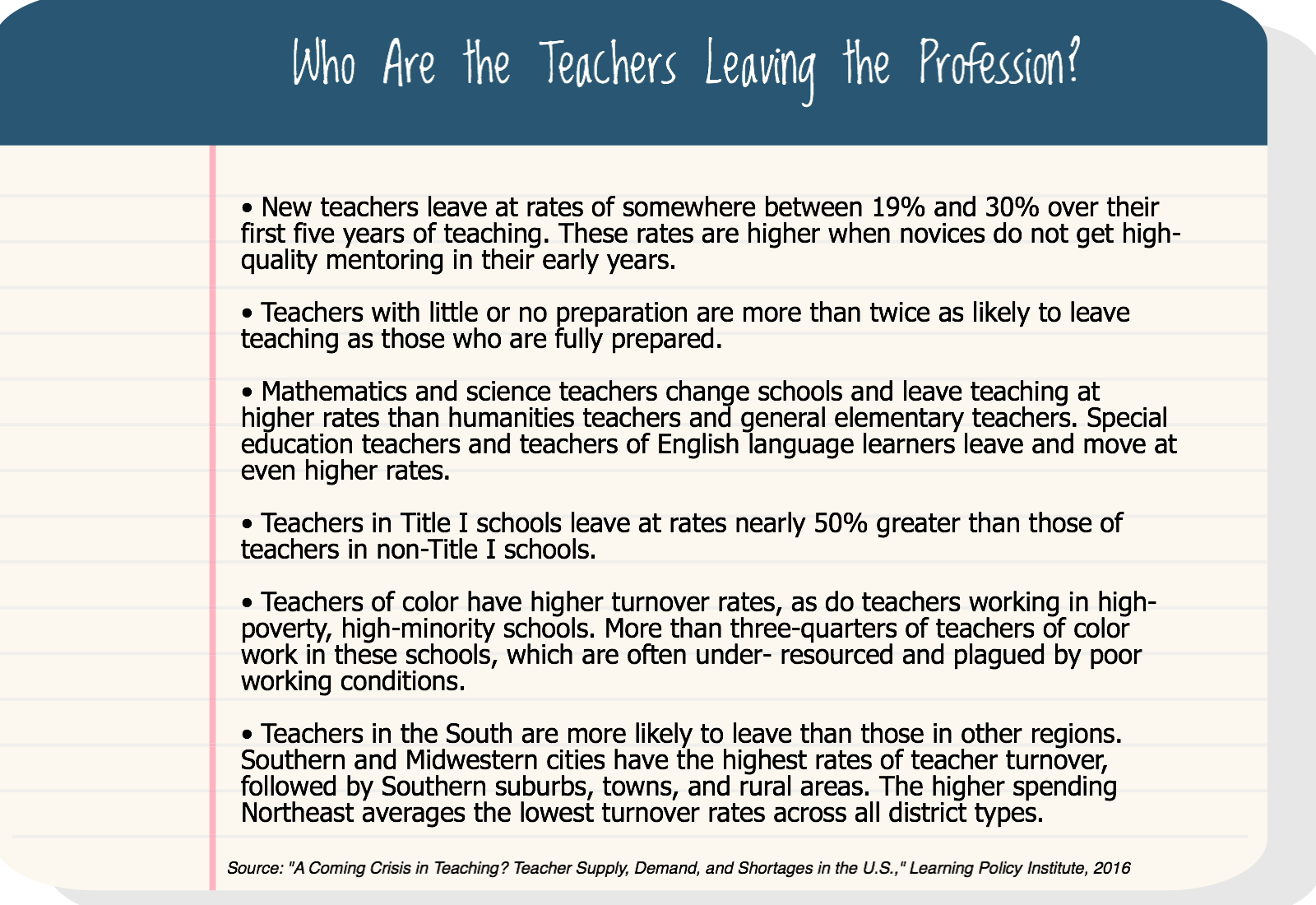 The United States is facing a major teacher shortage, as schools are scrambling to fill positions in math, science, special education, bilingual education, and other fields. The most severe deficit can be found in nearly all - 90 percent - of our highest-need schools.
The United States is facing a major teacher shortage, as schools are scrambling to fill positions in math, science, special education, bilingual education, and other fields. The most severe deficit can be found in nearly all - 90 percent - of our highest-need schools.
According to new research, attrition is fueling the teacher shortage crisis.
The Learning Policy Institute (LPI) recently released a package of reports that that provide the most comprehensive look to date at the causes and consequences of teacher shortages and offer evidence-based policy recommendations to develop a strong and stable teaching workforce.
According to the National Center for Education Statistics (NCES), the school-going population will increase by roughly three million students in the next decade. But while the number of students is growing, enrollment in teacher preparation programs is down significantly - falling 35 percent nationwide in the last five years.
The shortage, says Linda Darling-Hammond, president and CEO of LPI and co-author of A Coming Crisis in Teaching? Teacher Supply, Demand and Shortages in the U.S., is only going to get worse unless steps are taken now to address why so many are leaving the profession.
“The teaching profession continues to be a leaky bucket, losing more than 200,000 teachers each year,” Darling-Hammond explains. “And the gross numbers mask what already has become a critical shortfall in qualified teachers assigned to low-income and high-minority schools.”
 Needed: Better Teaching Conditions
Needed: Better Teaching Conditions
The attrition rates driving the teacher shortage crisis cannot be explained by retirements. The lion’s share leave because of dissatisfaction, LPI researchers found.
It comes as no surprise that many teachers are dissatisfied with their profession. Teacher salaries have been declining since the 1990s, and in thirty states around the country, a teacher who has a family of four is eligible for government assistance, including free or reduced-price lunch for their own children in school.
"Teaching conditions have hit a low point in the United States in terms of salaries, working conditions and access to strong preparation and mentoring -- all of which would attract and keep a stronger, more sustainable teaching pool," noted Darling-Hammond.
The Great Recession led to massive education budget cuts, but states have yet to return to pre-recession funding. Class sizes are ballooning, books, materials and computers are in short supply, and with more than half of public school students living in poverty, educators are often overwhelmed by the needs and learning challenges many low-income students bring to school.
But perhaps most dissatisfying is lack of support and respect. In many parts of the country, politicians and policy makers have scapegoated and vilified educators, while others have accused them of lacking accountability for poor performance.
At the same time, during the 13 years of No Child Left Behind, educators, were forced to teach to the test and strip not only their creativity from lesson plans, but also essential curriculum components - simply because they couldn't be tested.
National Education Association Vice President Becky Pringle addressed teacher dissatisfaction at a Learning Policy Institute forum on September 15.
“We have heard time and time again from our members that do not find that they have a seat at the table when decisions are made that affect their work with students," Pringle said. "In a 2013 international survey of teachers, only 34 percent of U.S. teachers said they believe teaching is valued by our society,” she said. “Furthermore, research shows that the level of autonomy teachers report having in their classrooms declined in the short period between 2003 and 2012.”
NEA is working with its state affiliates and locals to help recruit and retain educators - organizing and bargaining for issues that improve not only teachers working conditions, but student learning conditions. NEA also supports Grow Your Own (GYO) programs, which are designed to recruit, prepare and support educators, including education support professionals, to return to teach and work in their home communities, and is partnering with Educators Rising, which taps into the talents of high school students who are interested in teaching and early exposure.
"Teaching conditions have hit a low point in the United States in terms of salaries, working conditions and access to strong preparation and mentoring -- all of which would attract and keep a stronger, more sustainable teaching pool" -Linda Darling-Hammond
Preparation and support is critical. The LPI reports found that teachers with little preparation tend to leave at rates two to three times as high as those who have had a comprehensive preparation before they enter. In addition, schools in high-poverty and high-minority schools tend to have higher rates of attrition.
This raises equity concerns for students in in high-poverty and high-minority schools who have to bear the brunt of teacher shortages. When there are not enough teachers to go around, the schools with the fewest resources and least desirable working conditions are the ones left with vacancies.
Long-Term Solutions Over Stop-Gap Measures
Reducing attrition would actually make a greater difference in balancing supply and demand than any other intervention, the researchers found. In fact, reducing attrition by half could virtually eliminate shortages.
Some districts are responding with stop-gap measures, like allowing more unprepared educators to enter the classroom by lowering the standards required to become a teacher. This is a short-term fix with long-term problems: if teachers are hired without having been fully prepared, the much higher turnover rates that result are costly in terms of both dollars spent on the replacement process and decreases in student achievement in high-turnover schools.
Instead, long-term solutions are needed to keep educators in the profession by improving working conditions, increasing preparation and mentoring, and providing adequate resources that will enable them to do their jobs.
"We have to stop acting like we can solve this problem without resources," Pringle said.
Retaining and Recruiting Teachers - What Works
The Learning Policy Institute recommends several policies to attract and keep qualified educators :
- Create competitive, equitable compensation packages that allow teachers to make a reasonable living across all kinds of communities
- Enhance the supply of qualified teachers for high-need fields and locations through targeted training subsidies and high-retention pathways, including forgivable loans and service scholarships to attract and retain teachers to high-need fields and locations.
- Establish teacher residency models for hard-to-staff districts to recruit and retain talented and diverse candidates in high-need schools while better preparing them for the challenges they will face.
- Improve teacher retention, especially in hard-to-staff schools, through improved mentoring, induction, working conditions, and career development.
- Develop strong, universally available mentoring and induction programs to increase retention and help slow the revolving door of beginning teacher turnover.
- Create productive school environments, including supportive working conditions, administrative supports, and time for teachers’ collaborative planning and professional development—all of which help attract and keep teachers in schools.
Excerpted from "A Coming Crisis in Teaching? Teacher Supply, Demand, and Shortages in the U.S.," Learning Policy Institute, 2016







